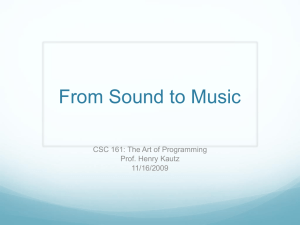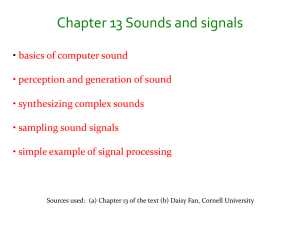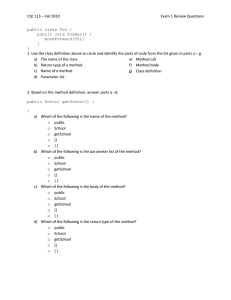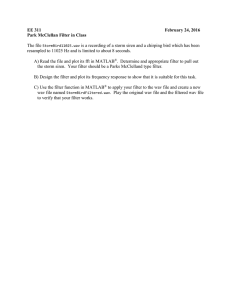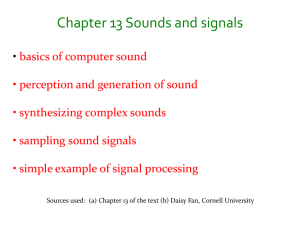L25. Working with Sound Files wavread sound
advertisement
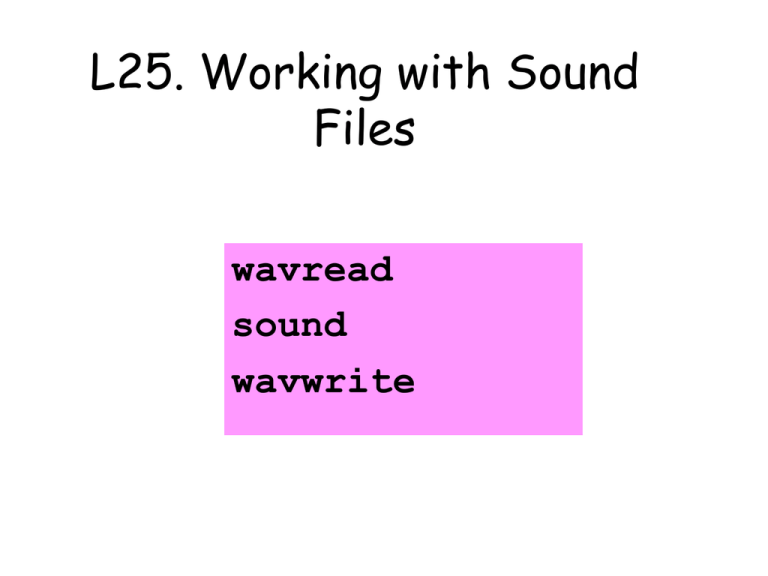
L25. Working with Sound
Files
wavread
sound
wavwrite
Reading and Playing
[y,rate,nBits] = wavread(‘noCry.wav’)
sound(y,rate)
How is audio information encoded?
We will work with .wav files
Discrete vs Continuous
Sound is continuous.
Capture its essence by sampling.
Digitized sound = 1-dim array of numbers
Quality Issue: Sampling Rate
If sampling not frequent enough, then the
discretized sound will not capture the
essence of the continuous sound…
Too slow
OK
Sampling Rate (Cont’d)
Given human perception, about 20000
samples/second is pretty good.
i.e., 20000 Hertz
i.e., 20kHZ
Sampling Rate (Cont’d)
8,000 Hz
required for speech over the
telephone
44,100 Hz
required for audio CD,
MP3 files
192,400 Hz
required for HD-DVD
audio tracks
Quality Issue: Resolution
Each sampled value is encoded as an
eight-bit integer in the .wav file.
Possible values: -128, -127,…,-1,0,1,…,127
Loud: -120, 90, 122, etc
Quiet: 3, 10, -5
8-bits usually enough. Sometimes 16-bits
Back to wavread
[y,rate,nBits] = wavread('noCry.wav');
n = length(y)
n =
77804
rate =
11025
nBits =
8
noCry.wav
encoded the
sound with 77,804
8-bit numbers
which were
gathered over a
span of about
77804/11025 secs
Let’s Look at the Sample Values
0.07031250000000
-0.13281250000000
-0.67968750000000
-0.51562500000000
0.21875000000000
0.48437500000000
0.71093750000000
0.57031250000000
0.14843750000000
0.39062500000000
0.25000000000000
[y,rate,nBits]
y(50000:50010)
values in between
-1 and 1.
= wavread(‘noCry.wav’)
Resolution with 8 Bits
For each sample, wavread produces one
of 256 possible floating point values:
-1
256 possible values : -1 + k/128
+1
Let’s Plot the Digitized Sound
[y,rate,nBits] =
n = length(y)
plot(y)
wavread(‘noCry.wav’)
Summary
Example:
Name of
the source
file.
[data,rate,nBits] = wavread(‘noCry.wav’)
The vector of
sampled
sound values
is assigned
to this
variable
The sampling
rate is
assigned to
this
variable
The
resolution
is assigned
to this
variable
Shortcuts
[data,rate,nBits] = wavread(‘noCry.wav’)
[data,rate] = wavread(‘noCry’)
Usually don’t care about nBits
Don’t need the .wav suffix
Playback via sound
[data,rate]= wavread(‘noCry’)
sound(data,rate)
Usually want playback at a rate
equal to the sampling rate.
To Compress or Not Compress
The .wav format does not involve
compression.
The .mp3 format does involve compression
and it reduces storage by a factor of
about 10.
Playlist
Suppose we have a set of .wav files, e.g.,
Casablanca.wav
AustinPowers.wav
GoneWithWind.wav
BackToSchool.wav
and wish to play them in succession.
Three Problems
1. Making a Playlist.
2. Segmentation
3. Splicing
Problem 1: Making a Playlist
PlayList = {'Casablanca',…
'AustinPowers',…
'GoneWithWind',…
'BackToSchool'}
for k=1:length(PlayList)
[y,rate] = wavread(PlayList{k});
sound(y,rate)
end
Prob: Will start playing Austin Powers before Casablanca finishes.
Built-In Delays
for k=1:length(PlayList)
[y,rate] = wavread(PlayList{k});
sound(y,rate)
L = length(y)/rate;
pause(L+1)
end
Compute how
long it’ll take
and add one
second.
Problem 2: Segmentation
Are You
Crying
There is
No crying
There is No Crying
In Baseball
Segmentation
Are You
Crying
There is
No crying
There is No Crying
In Baseball
Segmenting a .wav File
Read in a .wav file.
Display.
Identify segments using mouseclicks.
Store segments in a struct array.
Getting the Breakpoints
[data,rate] = wavread(F);
plot(data)
[x,y] = ginput;
x = floor(x);
nSegments = length(x)-1
Revisit ginput
This solicits two mouseclicks:
[x,y] = ginput(2)
This solicits mouseclicks until the
<return> key is pressed:
[x,y] = ginput;
From Breakpoints to
Subarray Extraction
data:
x:
2
7
19
29
Breakpoint
array via ginput
From Breakpoints to
Subarray Extraction
data:
7:18
2:6
x:
2
7
19
For kth segment:
First = x(k);
19:28
29
Last = x(k+1)-1
Setting up the Struct Array
for k=1:nSegments
First = x(k);
Last = x(k+1)-1;
z = data(First:Last);
C(k) = struct('rate',rate,…
'z',z);
end
Playing the Segments
function PlaySegments(C)
for k=1:length(C)
theData = C(k).z;
theRate = C(k).rate;
sound(theData,theRate)
pause(length(theData)/theRate +1)
end
That’s how long it takes the
Kth segment to play.
Making a .wav File
Suppose C is a struct array consisting of
N sound segments all sampled at the same
Rate.
Make a single .wav file that plays the
segments in reverse order.
Reversing the Segments
function Reverse(C,F)
n = length(C);
y = [];
for k = 1:n
y = [ C(k).z ; y];
end
wavwrite(y,C(1).rate,8,[F '.wav']);
wavwrite
wavwrite(data,rate,nBits,fname)
Target file,
e.g.,
‘F.wav’
